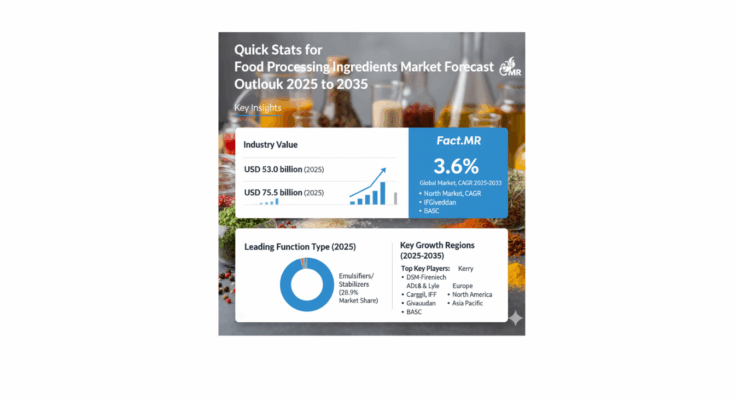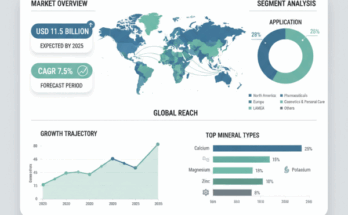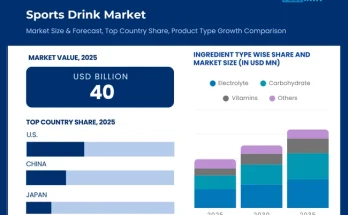The global food processing ingredients market is set to experience substantial growth over the next decade, projected to rise from USD 53.0 billion in 2025 to USD 75.5 billion by 2035, reflecting an impressive CAGR of 3.6%. This surge is fueled by escalating demand for functional food ingredients, clean label solutions, and advanced processing technologies that enable manufacturers to optimize product functionality, enhance operational efficiency, and maintain quality compliance across bakery, beverage, and dairy segments worldwide.
The market trajectory is strongly influenced by innovations in emulsifiers and stabilizers, which currently account for 37% of the market share, underscoring their critical role in ensuring product stability, texture enhancement, and process reliability. Meanwhile, preservatives and enzyme-based ingredients maintain notable market positions at 33% and 30%, respectively, driven by specialized applications in shelf-life extension, functional optimization, and tailored food processing solutions.
Food Processing Ingredients Market Growth Phases
The forecast period can be divided into two distinct phases. Between 2025 and 2030, the market is expected to expand from USD 53.0 billion to USD 63.5 billion, contributing 46.7% of the total ten-year growth. This period is characterized by rising demand in bakery and confectionery operations, beverage formulation programs, and enhanced integration of ingredient platforms with food processing systems. Companies are focusing on strategic expansions and specialized processing capabilities, positioning themselves as key providers of advanced emulsifier and stabilizer solutions.
From 2030 to 2035, the market will further grow from USD 63.5 billion to USD 75.5 billion, representing 53.3% of the decade’s overall growth. This phase emphasizes plant-derived functional ingredients, next-generation processing solutions, and partnerships between global ingredient manufacturers and food companies. Sustainability and clean-label standards will shape investment priorities, with increasing adoption of natural ingredient technologies tailored for specific food processing requirements.
Food Processing Ingredients Market Regional Dynamics and Key Markets
The United States is anticipated to lead global growth with a 3.9% CAGR, driven by food processing infrastructure development, innovation programs, and robust operational standards. Major processing hubs such as California, Illinois, New York, and Texas are adopting advanced functional ingredient platforms that integrate seamlessly with operational and quality management systems.
Mexico, with a 3.6% CAGR, represents a high-growth market fueled by operational scaling, government food programs, and increasing demand for functional ingredient solutions in bakery, beverage, and dairy sectors. Similarly, Germany (3.2% CAGR) and France (3.1% CAGR) demonstrate strong growth potential, leveraging established food manufacturing infrastructure, ingredient innovation initiatives, and regulatory compliance programs to drive adoption of advanced ingredient technologies.
In Asia Pacific, South Korea (2.9% CAGR) and Japan (2.8% CAGR) are focusing on technology integration, operational efficiency, and quality-driven ingredient solutions. Korean companies are increasingly collaborating with global providers like Kerry, DSM-Firmenich, and Tate & Lyle to implement hybrid service models that combine international expertise with local operational capabilities. In Japan, functional ingredient excellence supports high-precision food processing and operational optimization, with efficiency improvements reported up to 38% in integrated food facilities.
Food Processing Ingredients Market Application and Functional Insights
Bakery & Confectionery applications dominate market share at 41%, driven by increasing product innovation, formulation complexity, and rising demand for specialized ingredient solutions. Functional ingredients enable superior dough stability, texture optimization, and shelf-life enhancement, making them critical to operational efficiency.
Beverages represent 28% of the market, with specialized functional requirements for processing, flavor consistency, and shelf-life maintenance. The growing demand for functional and plant-based beverages is driving the adoption of integrated ingredient solutions, including emulsifiers and enzyme systems.
Dairy & Other applications account for 31%, encompassing processed foods, dairy products, and specialty formulations that rely on functional ingredient platforms for operational reliability and product consistency.
Food Processing Ingredients Market Drivers and Trends
The market is propelled by three core demand drivers:
- Functional food acceleration: Expanding demand for functional foods, including protein-enhanced, plant-based, and nutraceutical-infused products.
- Regulatory and safety initiatives: Government programs promoting food safety, clean-label adoption, and functional ingredient standards.
- Technological advancements: Ingredient innovation and integration with automated food processing systems that improve operational efficiency and product functionality.
Key trends include accelerated adoption of plant-derived ingredient platforms, real-time monitoring integration, and sustainability-driven processing technologies. Emerging regions such as Asia-Pacific show rapid expansion in food processing infrastructure, providing fertile ground for global ingredient providers.
Food Processing Ingredients Market Competitive Landscape
The market comprises 20-25 credible players, with the top five controlling 22-27% of global market share. Kerry, DSM-Firmenich, and Tate & Lyle dominate due to comprehensive ingredient portfolios, formulation expertise, and strong customer relationships. Challengers such as ADM and Cargill compete through regional specialization and technology-driven solutions, while innovators like Ingredion, IFF, and Givaudan focus on differentiated application systems and operational optimization.
Market leadership is increasingly determined by formulation expertise, operational reliability, and technical support, rather than price competition alone. Regional players in Asia Pacific and North America gain advantage through rapid deployment, localized support, and regulatory compliance expertise.
Food Processing Ingredients Market Outlook for Industry Leaders
With a projected USD 22.5 billion increase over the decade, industry leaders are poised to leverage growth opportunities through:
- Development of next-generation emulsifiers and stabilizers.
- Expansion of plant-derived and functional ingredient platforms.
- Strategic collaborations with global and regional food manufacturers.
- Integration of automated ingredient management and monitoring solutions.
- Investment in operational support services, technical expertise, and clean-label certifications.
The Food Processing Ingredients Market offers substantial growth potential for companies aiming to enhance product functionality, processing efficiency, and consumer acceptance. Manufacturers investing in advanced ingredient solutions are well-positioned to capture market share and capitalize on emerging trends in functional food, sustainability, and global food safety standards.
Browse Full Report : https://www.factmr.com/report/846/food-processing-ingredients-market



